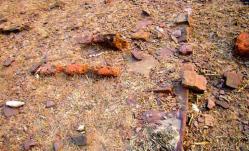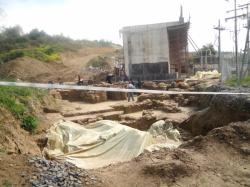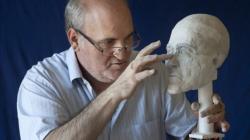INSTITUT SUPERIEUR D'ANTHROPOLOGIE
INSTITUTE OF ANTHROPOLOGY
ONLINE COURSES / COURS A DISTANCE
SPRING SESSION : APRIL 2013
REGISTER NOW
INDE –  Tarighat - The surface findings at the archaeological site located on the left bank of river Kharun, a tributary of Sheonath river, indicate that the ancient city buried underneath was a highly developed urban settlement and flourished in the third century BC. Preliminary explorations have yielded Kushan and Satavahan coins, a stone seal, potteries, beads of semi-precious stones, terracotta and bones. The Archaeological Survey of India (ASI) has granted licence for excavation of the site to the Chhatt-isgarh state archaeological department on the basis of the findings. “The ruins indicate that the settlement dates back to third century BC. But, there may be possibility of retrieving settlements dating back as far as sixth century BC when we go further deep”, deputy director of Chhattisgarh archaeological department J.R. Bhagat said. According to Atul Pradhan, archaeologist and member of the excavation team, four huge mounds of about 15 feet height from ground level have been found. A portion of one of the mounds located in the east was washed away by a river exposing around 15 layers of soils in different forms indicating existence of structures buried inside. In the sixth layer, a patch of burnt clay circled aro-und one of the mounds. This indicates the ancient city might have been completely burnt and later revived. All four mounds are still intact. Impre-ssions of a courtyard and common road inside the city are clearly visible.
Tarighat - The surface findings at the archaeological site located on the left bank of river Kharun, a tributary of Sheonath river, indicate that the ancient city buried underneath was a highly developed urban settlement and flourished in the third century BC. Preliminary explorations have yielded Kushan and Satavahan coins, a stone seal, potteries, beads of semi-precious stones, terracotta and bones. The Archaeological Survey of India (ASI) has granted licence for excavation of the site to the Chhatt-isgarh state archaeological department on the basis of the findings. “The ruins indicate that the settlement dates back to third century BC. But, there may be possibility of retrieving settlements dating back as far as sixth century BC when we go further deep”, deputy director of Chhattisgarh archaeological department J.R. Bhagat said. According to Atul Pradhan, archaeologist and member of the excavation team, four huge mounds of about 15 feet height from ground level have been found. A portion of one of the mounds located in the east was washed away by a river exposing around 15 layers of soils in different forms indicating existence of structures buried inside. In the sixth layer, a patch of burnt clay circled aro-und one of the mounds. This indicates the ancient city might have been completely burnt and later revived. All four mounds are still intact. Impre-ssions of a courtyard and common road inside the city are clearly visible.
http://www.deccanchronicle.com/130311/news-current-affairs/article/2500-yr-old-city-found-buried-chhattisgarh
GRECE –  Antikalamos - During road construction works near Kalamata (southwestern Peloponnese), the remains of a Mycenaean settlement have been found. Director of the 38th Ephorate of Prehistoric and Classical Antiquities, Anna Karapanagioti said it is the first time ancient remains have been located so close to the city of Kalamata. “Up to now we had settlements in Pylia, while in the wider region, in Ancient Thouria, tombs and cemeteries have been found”. According to Mrs. Karapanagioti, fragments of wall paintings and figurines have also been revealed within the settlement. The archaeological surveys will continue.
Antikalamos - During road construction works near Kalamata (southwestern Peloponnese), the remains of a Mycenaean settlement have been found. Director of the 38th Ephorate of Prehistoric and Classical Antiquities, Anna Karapanagioti said it is the first time ancient remains have been located so close to the city of Kalamata. “Up to now we had settlements in Pylia, while in the wider region, in Ancient Thouria, tombs and cemeteries have been found”. According to Mrs. Karapanagioti, fragments of wall paintings and figurines have also been revealed within the settlement. The archaeological surveys will continue.
http://www.archaiologia.gr/en/blog/2013/03/11/mycenaean-settlement-in-antikalamos/
FRANCE – Ajaccio - En 2005 les fouilles d’archéologie préventive avaient permis de mettre au jour un baptistère paléochrétien du VIe siècle sous le site Alban. Un site classé depuis le 14 février aujourd’hui malmené. Et alors que l'imposant complexe Alban construit par la famille Torre est quasiment achevé, on découvre que le baptistère qui avait fait couler tant d'encre et mobilisé tant d'énergie est aujourd'hui le centre de ce qu'il faut bien appeler par son nom : une décharge à gravats. Pierre Casanova président du collectif San Ghjuvà est plus qu'alarmé. « Il n'y a plus de sable sur le site. Les bâches de protection sont en parties retirées, l'eau ruisselle entre les pierres »,note-t-il. L'édifice paléochrétien était bordé de tombes médiévales. Certaines n'avaient pas été touchées car elles se trouvent en partie sous le trottoir et la chaussée. Elles devaient, dans le projet d'antiquarium, être visibles à travers une vitre, depuis le musée. Désignant du doigt le « chemin » de béton qui longe le trottoir en contrebas, il fulmine : « Ils ont creusé et bétonné. Sur quelle profondeur ? Personne n'en sait rien. Que sont devenues les tombes ? On l'imagine… »
http://www.corsematin.com/article/ajaccio/a-ajaccio-le-baptistere-san-ghjuva-sera-t-il-la-premiere-decharge-classee.922258.html
GRECE –  Crète - An interdisciplinary research group of the University of Crete, the Technological Institute of Crete and the University Hospital of Heraklion conducted a survey in order to create a facial reconstruction of Saint Eutychius, based on the saint’s skull. The saint’s facial reconstruction will be presented today, March 11th. Saint Eutychius was Bishop of Gortyna and Archbishop of Crete. It is assumed that the saint lived during the Arab conquest of Crete (827-961 AD). His head is kept in the Monastery of Odigitria (in Messara), one of the oldest monasteries in Crete.
Crète - An interdisciplinary research group of the University of Crete, the Technological Institute of Crete and the University Hospital of Heraklion conducted a survey in order to create a facial reconstruction of Saint Eutychius, based on the saint’s skull. The saint’s facial reconstruction will be presented today, March 11th. Saint Eutychius was Bishop of Gortyna and Archbishop of Crete. It is assumed that the saint lived during the Arab conquest of Crete (827-961 AD). His head is kept in the Monastery of Odigitria (in Messara), one of the oldest monasteries in Crete.
http://www.archaiologia.gr/en/blog/2013/03/11/face-to-face-with-a-saint/
ITALIE –  Herculaneum - Shimmering as if still lit by the Mediterranean sun, two spectacular Roman marble panels have been reunited at the British Museum for the first time in almost 2,000 years. Both come from a seaside mansion in Herculaneum, the town overwhelmed by a torrent of boiling mud from Vesuvius, when the wind changed direction 12 hours after Pompeii had already choked to death. The remains of the owner of the palatial villa may still lie on the ancient shoreline, now half a mile inland. In AD79 the sea was the beautiful view that his sumptuously decorated room looked out on, with its fourth wall open to the sea. The first of the marble reliefs, an ecstatic and tipsy celebration of the god Bacchus, was found at Herculaneum in a controversial excavation 30 years ago. The excavation was launched to find more of the House of the Papyri, an extraordinary complex the size of a small village, most of which is still buried under the modern town. When it was discovered in the 18th century almost 2,000 papyrus scrolls, a princely library, were recovered along with wonderful sculptures. The 20th-century excavations failed to find any more scrolls, but did uncover a previously unknown villa terraced down to the sea and one of the marble panels. The reliefs, in the classical Greek style – possibly carved by a Greek artist for a Roman master – were wildly fashionable among the wealthy of Herculaneum and the Roman elite. There are records of the philosopher and statesman Cicero seeking such panels to decorate his home. It was feared the excavation had destabilised the site, so three years ago the American-financed Herculaneum Conservation Project, which has been working in the town for the last decade, returned for consolidation work. On the last day of the work, mud caked on a broken wall fell away revealing the second panel, in pristine condition. It has never been exhibited before. Roberts suspects there must have been a third panel, on a wall that was swept into the bay below in the eruption that ended the life of the town and ensured its place in history. "Like so much of the town and its people, the third panel must have been crushed to atoms – we're so astonishingly lucky in what has been left to us to bear witness to what has been lost."
Herculaneum - Shimmering as if still lit by the Mediterranean sun, two spectacular Roman marble panels have been reunited at the British Museum for the first time in almost 2,000 years. Both come from a seaside mansion in Herculaneum, the town overwhelmed by a torrent of boiling mud from Vesuvius, when the wind changed direction 12 hours after Pompeii had already choked to death. The remains of the owner of the palatial villa may still lie on the ancient shoreline, now half a mile inland. In AD79 the sea was the beautiful view that his sumptuously decorated room looked out on, with its fourth wall open to the sea. The first of the marble reliefs, an ecstatic and tipsy celebration of the god Bacchus, was found at Herculaneum in a controversial excavation 30 years ago. The excavation was launched to find more of the House of the Papyri, an extraordinary complex the size of a small village, most of which is still buried under the modern town. When it was discovered in the 18th century almost 2,000 papyrus scrolls, a princely library, were recovered along with wonderful sculptures. The 20th-century excavations failed to find any more scrolls, but did uncover a previously unknown villa terraced down to the sea and one of the marble panels. The reliefs, in the classical Greek style – possibly carved by a Greek artist for a Roman master – were wildly fashionable among the wealthy of Herculaneum and the Roman elite. There are records of the philosopher and statesman Cicero seeking such panels to decorate his home. It was feared the excavation had destabilised the site, so three years ago the American-financed Herculaneum Conservation Project, which has been working in the town for the last decade, returned for consolidation work. On the last day of the work, mud caked on a broken wall fell away revealing the second panel, in pristine condition. It has never been exhibited before. Roberts suspects there must have been a third panel, on a wall that was swept into the bay below in the eruption that ended the life of the town and ensured its place in history. "Like so much of the town and its people, the third panel must have been crushed to atoms – we're so astonishingly lucky in what has been left to us to bear witness to what has been lost."
http://www.guardian.co.uk/science/2013/mar/10/archaeology-museums